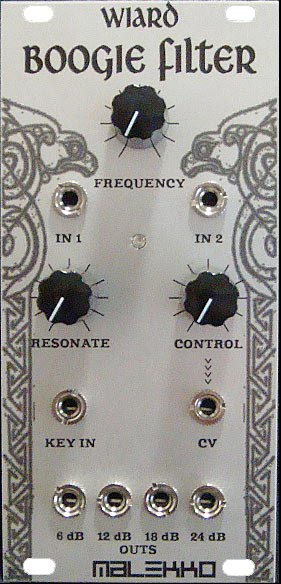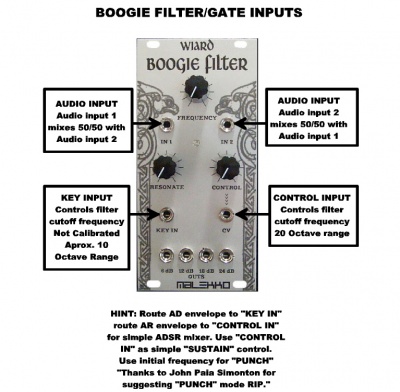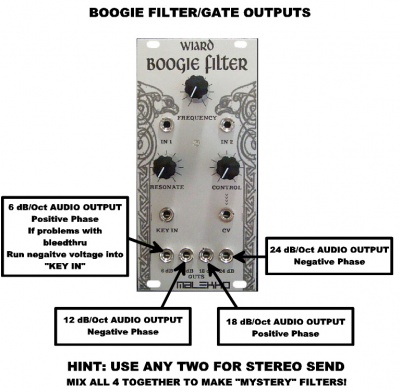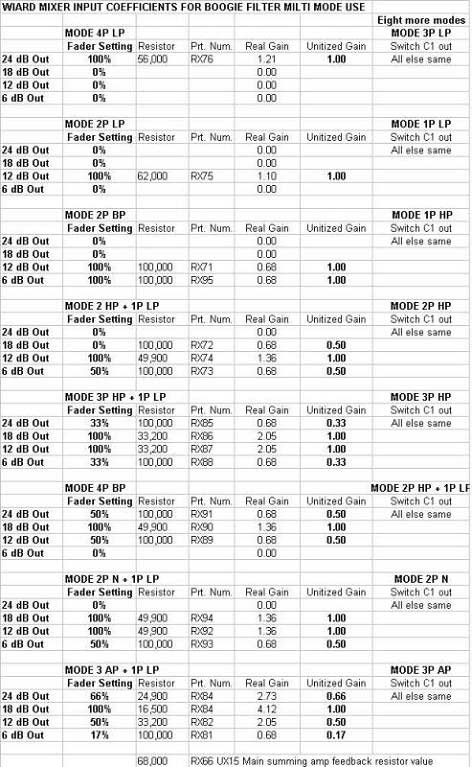Malekko/Wiard Boogie Filter[modifier]
Buchla-Moog Filter
from the muff
Boogie: Used as a Gate the trimpot on the back is adjust so the 6dB output is at -60dBv for a 100 Hz sine wave with freq and freq env. at zero. This is a compromise, it allows the top end to reach 20kHz and have a lot of "air".
-60dBv was considered a good spec. back in the old days.
By adjusting the trimpot, you can lower the bottom frequency and amount of cutoff at 6dB output at the expense of high end frequency. Busted trimpots are not covered under warranty, so if you don't know what your doing, please don't mess with it.
Boogie info[modifier]
https://www.muffwiggler.com/forum/viewtopic.php?p=760697#760697
BOOGIE INFO:
The two major variables in filter design are the topology and the transconductor type. A transconductor for synthesizers in simple terms is just a voltage controlled resistor.
The Moog transistor ladder, EMS diode filter and the Boogie filter are all 4 pole Butterworth lowpass filters. Each LP filter "pole" or stage reduces the output by 6 dB per octave. What that techno speak means is each time the frequency doubles, the amplitude is reduced by half. Putting 4 stages in series makes a 24 dB per octave filter, or each time the frequency doubles, the output is reduce to 1/16. The Moog ladder uses transistors as the transconductor, the EMS uses diodes and the Boogie filter uses Vactrols as the transconductor. In theory, there should be no difference in the "sound" of all three. But the ear is such a fantastic discriminator, that it can detect the mathematical defects in each design, so they sound slightly different.
The Boogie (from Boog "Buchla + Moog") uses Vactrols as the transconductor. This should be the closest to mathematically perfect, because the photo resistors are true conductors, not semi-conductors used in a current starved mode to behave as AC resistors. Also the Vactrols optically isolate the control signals from the audio path, eliminating any control voltage bleedthru or thumping.
Another advantage is that resistors are not active noise sources like transistors or diodes, so there is much less "hiss" to deal with. There is always some hiss because electricity does not flow in a perfectly smooth stream but rather in "clumps" of various size groups of electrons. When this "clumpy" current passes through a resistor, it produces a clumpy voltage because of Ohms Law (E = I * R). That is called thermal noise, because the molecular vibrations cause the chaotic electron behavior which we perceive as clumpyness. It is actually a chaotic system of coupled oscillators where each molecule is an oscillator, but that is getting too far out.
Semi-conductors have an added noise source which is the "diode drop" a kind of quantum waterfall, where more clumpyness is added as the electron groups try to decide if they are going to go over the waterfall or not. This is where the noise comes from in a reverse bias transistor. You just hook the transistor up in the worst possible way to bring out the quantum waterfall noise.
So the Boogie is designed to have less noise and distortion than the Moog or EMS implementations of a Butterworth 4 stage filter. This may disappoint people who LIKE noise and distortion. My philosopy is to start with the least possible distortion, then use either over driving or special circuitry to add it back in when you want it.
For the technically inclined, have a look at
http://www.musicsynthesizer.com/Circuitry/Multi-Function%20VCF.htm
The opening block diagram is practically a schematic for the Boogie filter with A,B,C and D being the 6,12,18 and 24 dB per octave outputs. The mixing is done externally by YOU. The resistors shown are actual Vactrol resistors in the Boogie design, instead of a shorthand symbol for the OTA's in a 3372 chip. That eliminates about 100 transistors from the signal path, and should be much quieter. Plus the mixer can be VCA based like the Blacet Quad VCA. So a sequencer or 4 envelopes can be used to mix the filter "poles" for filter mode sequencing or envelope morphing.
Here are some operating notes:
This is an extension of the Lowpass Gate technology using a Butterworth circuit instead of a Sallen-Key. But it is still a gate, and goes all the way off. You can use it like a combo VCF-VCA. The Frequency control range is very wide, from off to 20 kHz. The wide range is to accomodate using the 6 dB/Oct output like a VCA. It will gate either audio or control voltages.
You can use it like a Mini-Moog type filter, in addition to using it like a Lowpass Gate.
With high levels of resonance, the filter will produce distortion at the cutoff frequency. This is useful for processing tracks.
The red jumpers on the back control the phase of the 12 and 24 dB/octave outputs. In the bottom position, the phase is inverted. In the top position, the phase is positive. When mixing the different outputs, the inverted phase allows the Matrix 12 type responses. If you move them to the top position, you can use a JAG and 4 VCAs to make a variable slope filter.
For some background information on using the Boogie Filter for other filter types, see:
http://www.musicsynthesizer.com/Circuitry/Multi-Function%20VCF.htm
which is the section from the service manual on the Oberheim Expander filter. Of course the Boogie Filter uses discrete Vactrols rather than the CEM chip for improved noise and distortion. Cell one is the 6 dB output, cell two is the 12 dB output and so on. Notice the inverters on the 12 and 24 dB outputs, which makes the math "trick" work. You can get some idea of mixing coefficients from the resistor values in the summing networks.
> Sorry if it's obvious, but could someone tell me exactly what a low > pass gate is, and how I can use my Boogie filter as such?
It's a mode unique to photo-electric filters. Any other transconductor (transistor, diode, OTA) can not run to zero control current without making bad things happen to the DC bias and producing 15 volt thumps. But photo-electric filters go completely off (0 Hz). This allows you to use the filter as a combined VCF and VCA.
In the West Coast model, the complex timbres are generated before the filter via complex oscillators, non-linear waveshapers, FM or additive synthesis. The "gate" is then used for final amplitude and spectral shaping.
The Boogie supports both modes, either straight subtractive with a following VCA, like the East Coast instruments, or gating and spectral shaping without a following VCA, like the West Coast instruments.
The main frequency control covers 20 octaves, 0 to 20 Hz, which is 10 octaves, and 20 Hz to 20 kHz, which is another 10 octaves.
To "gate" with the Boogie, set initial frequency to zero and control range to max. Resonance is set to zero. A 10 volt signal into "Control In" will then sweep the filter from 0 Hz to 20 kHz. The 6 dB output is approx. equivalent to the Buchla 292 "combo" mode, and the 12 dB output is approx. equivalent to the 292 "filter" mode. But the Hamamatsu opto- couplers decay in 20 ms., rather than the 200 ms. decay of the VTL5C3/2 used in the Buchla 292C.
One jumper is for the 24 dB output and the other for the 12 dB output. Move both to top position if your mixing with the Blacet Mixer Processor. Leave both at bottom position if you are mixing with the Blacet Quad VCA.
The effect is high frequency roll off over distance with humidity (adds friction to air). That was the error in the speed of sound measurement variation that Newton never solved. It took 200 years after his death to figure it out (according to PBS). The VCA (or Combo) mode is 6 dB per octave, probably average humidity. 3 dB / Oct would be dry air and 12 dB / Oct would be a visably foggy night (just guessing). Also the 6 dB output of the Boogie can be used for the same effect.
To Summarize: Humidty forms a lowpass filter over distance in air. To simulate this effect in panning, use low pass gates (Borg, Boogie) instead of plain VCAs.
I finally got around to writing an Excel spreadsheet to calculate all the gain settings for the Xpander switchable mixer. (See BoogieModes.jpg) That is what that mess of resistors does before UX14, a CD4051 eight way selector switch. A little later I will write a note to show how to add a simple switch between C1 and ground which will add in the other 8 modes for a total of 16. I unitzed the spreadsheet data to use with the Boogie Filter and any 4 input linear mixer. The file is called Multimode.jpg, you will need to view it at the largest size, or download it.
The table assumes all 4 Boogie outputs are connected to all 4 inputs on a mixer with unity gain output and controls calibrated 0 to 100%. The table also assumes the two red option jumpers on the rear of the Boogie Filter are in the down position. 100% means fader is fully on, 0% means fader is fully off. 50% is fader at halfway point and so forth. There are a few 33% settings and a 17% setting. Feel around the suggested starting points for best results.
All of these are only suggested starting points. ANY setting of the mixer faders will produce some kind of filter. As always with music, adjust by ear and personal taste. You may very well discover a setting Oberheim never even knew existed. Consider running the 24, 18, 12 and 6 dB poles through different effects chains. Unlimited sonic possibilities.
Boogie Filter's 16 Different Modes (Both red jumpers must be in the DOWN position):
Out Of The Box:
1) 4 Pole Low Pass: 24 100% 18 0% 12 0% 06 0%
2) 3 Pole Low Pass: 24 0% 18 100% 12 0% 06 0%
3) 2 Pole Low Pass: 24 0% 18 0% 12 100% 06 0%
4) 1 Pole Low Pass: 24 0% 18 0% 12 0% 06 100%
With External Mixing:
5) 2 Pole Band Pass: 24 0% 18 0% 12 100% 06 100%
6) 2 Pole High Pass + 1 Pole Low Pass: 24 0% 18 0% 12 100% 06 50%
7) 3 Pole High Pass + 1 Pole Low Pass: 24 33% 18 100% 12 100% 06 33%
8) 4 Pole Band Pass: 24 50% 18 100% 12 50% 06 0%
9) 2 Pole Notch + 1 Pole Low Pass: 24 0% 18 100% 12 100% 06 50%
10) 3 Pole All Pass + 1 Pole Low Pass: 24 66% 18 100% 12 50% 06 17%
With External Mixing Plus C1 Switched Out:
11) 1 Pole High Pass: 24 0% 18 0% 12 100% 06 100%
12) 2 Pole High Pass: 24 0% 18 0% 12 100% 06 50%
13) 3 Pole High Pass: 24 33% 18 100% 12 100% 06 33%
14) 2 Pole High Pass + 1 Pole Low Pass: 24 50% 18 100% 12 50% 06 0%
15) 2 Pole Notch: 24 0% 18 100% 12 100% 06 50 %
16) 3 Pole All Pass: 24 66% 18 100% 12 50% 06 17%
THE WIARD PHILOSOPHY:
I will try to explain a little of the philosophy behind the Wiard modules. It has to do with the "East vs. West" coast synthesizer history. This is an over simplified explaination, some "East Coast" instruments support FM for example.
It really starts with the concept of a patch. In the "East Coast" instruments (basically all synthesizer manufacturers except Wiard, Buchla and Serge) you have a subtractive synthesis patch entirely oriented towards the filter. This is your classic VCO-VCF-VCA connection with ADSR type envelopes. The envelopes generators typically have only a single output. The oscillators usually have very simple waveforms such as sawtooth and square wave. This is what most people are introduced to and why many people are puzzled by more complex instruments like the Wiard. This patch makes sense for playing with a black and white type keyboard. It produce a limited but pleasing range of timbres and is easy to operate and understand.
In the "West Coast" instruments, there are 3 possible synthesis modes. Additive, non- linear waveshaping and dynamic depth FM are the primary synthesis modes. "East Coast" subtractive synthesis is typically not DIRECTLY supported. It was not in the Buchla or Serge (no 24 dB/Oct. resonant filter). Good aproximations of subtractive synthesis can be patch on the Serge with cascaded filters. These instruments are oriented towards controlling with a multiple output sequencer or multiple output complex envelope generator intead of a black and white keyboard. They produce a larger and more importantly, different set of timbres than the simpler "East Coast" instruments.
The classic patch in a "West Coast" instrument involves two blocks. The first is a complex oscillator which supports both non-linear waveshaping and dynamic depth FM (Buchla 259 and Serge NTO). The second signal processor is a Lowpass Gate or "frequency and amplitude domain processor". The primary timbre generation is done directly with the oscillator, and the Lowpass Gate just tweaks the amplitude and frequency character. These two blocks are designed to be controlled by one complex envelope generator with multiple outputs routed to all the timbre factors.
Once again this is a simplifed explaination to illustrate subtle points. Actual usage involves a combination of both techniques.
In the 1200 series we have the groundwork laid for a complex "West Coast" voice. The JAG will convert two simple ADSR envelopes into a multiple output complex envelope generator. The Boogie Filter can be used as a Lowpass Gate but also supports the "East Coast" Moog type subtractive character. The Borg 2 Filter is a classic Lowpass Gate that can also be used like the "East Coast" MS20 subtractive filter.
The icing on the cake is the complex oscillator. The Wiard Synthesizer Mini-Wave and VCO (manufactured under license by Blacet Research) is a type of complex oscillator and non- linear waveshaper already well established. A lot of good work has been done with these Wiard designs. Improving on such a solid base is no easy task.
It would be great if a complex oscillator could support as many timbre modes as possible. Simultaneous support for multiple non-linear waveshaping, dynamic depth PM and wavetable would be ideal. If each of these was independent, you could look at them like geometric axis. Modulating the timbre parameters then becomes a matter of "walking about" in a large timbre space with multiple dimensions of simultaneous control. This is true timbre morphing and not just simple crossfading between timbres (which is good too).
This is where my research is currently focused. Exactly when the complex oscillator will be finished depends upon sales of the existing 1200 series modules. If the public is not interested in the extra "West Coast" synthesis methodology, it would be foolish to waste time and money on products for that purpose.
"East Coast" designs are as common as dandelions, but I feel support for subtractive synthesis should be included in a complete instrument. That is why the Wiard designs support BOTH East and West Coast synthesis methods. For example, any Wiard complex VCO will include classic subtractive waveform outputs in addition to the complex outputs.
I think that I need to focus on education to promote the idea of the more complex synthesis "West Coast" style. I am going to try and write manuals for the Boogie and Borg 2 modules that cover the less obvious operating modes. For the short term, I will be concentrating on that.
As always, thank you to all you fine people for your continued support and all the amazing music you have sent me. Keep up the good work and thank you again.
Some more comments on "West Coast" techniques.
The main difference between the two techniques are how the filter is applied. In "East Coast" technique, you start with simple waveforms and used the filter to do your timbre control. The classic East Coast patch is VCO - VCF - VCA with ADSR envelopes for the VCF and VCA.
In one of the "West Coast" techniques, you start with complex waveforms and use the filter just to do final tone shaping. Of course crank up the resonance if you want to mix the two techniques.
How do you get complex waveforms? The Wiard-Blacet Mini-wave or 300 series Waveform City is a good source of complex waveforms when used as a wavetable playback device. These complex waveforms can be made even more complex by the use of synch and FM at the same time. The Mini-wave/Wavefrom city can also be used as a wave multiplier for non-linear synthesis.
Here are a couple of simple patches that are "West" sounding.
VCO(sine) - VCA - LINFMVCO(sine) - Borg in lowpass gate mode (VCA).
You use the first VCA to dynamically control the depth of linear FM. Envelopes are routed to the FM depth VCA and to the Borg tone shaper. The use of sine waves produces "nice" sounding FM along with the soft Borg envelope. With the first VCO set to about 7 Hz and the linear FM control of the second VCO barely open, you have dynamic and natural sounding vibrato.
VCO(sine) - LINFMVCO(sine) - VCA - Mini-wave(+/- 5v) - Borg in lowpass gate mode (VCA)
This is a fixed depth FM patch going to a dynamic depth wave multiplier. Envelopes are routed to the first VCA and to the Borg. The VCA before the Mini-Wave needs to have controls to set initial volume and control the amount of envelope (like an ARP 2600 VCA has). You want to adjust the VCA so it is about 20% on with no envelope. Then adjust the amount of envelope sweep to your taste. You can play with any bank or wave in the Mini- wave but Bank 13 is designed just for this use.
Banks 0 to 7 of the "Socket Rocket" chip are designed to process audio input. In this case the VCA is set 100% on. Bank 6 "Bit Decimation" can really make a drum track gnarly when set to 4 bits or less. One thing to look at is the "Socket Rocket" users manual. This is a 10 meg pdf file:
http://www.musicsynthesizer.com/DIY/Grant/grant_richters_synthdiy.htm
and scroll to the bottom under "Discontinued Products" Right click on "Socket Rocket Final Manual" and save the pdf file to the desktop or your prefered location. This has ideas for using the waves in the Socket Rocket chip. I used an ARP 2600 and 1630 sequencer to reference the patches.
FILTERS IN MUSICAL TERMS:
It may be helpful to discuss filters in musical terms, rather than engineering terms.
Two 12 dB/Oct filters can always be put in series to make a 24 dB/Oct filter. "Compound" filters like this are essential to really creative synthesis. Another example is a bandpass filter in parallel with a lowpass filter. The reason for this is to make a Formant. Using the lowpass with resonance, and offsetting a parallel band pass with resonance you get a formant. Drive both with a narrow pulse wave and you have a primitive voice synthesizer that can give you vowel like sounds (if the filters are tuned properly). Using a Joystick to control each filter allows you to "speak" different vowels (well, like EEEE and AAAA). If you have two filters try it, it's fun.
A waveform processed by a 12 dB/Oct filter will have stronger harmonic content relative to the fundamental. The tone will be "brighter" in musical terms. These voices are usually used in the treble register as lead voices playing the melody or counterpoint.
A waveform processed by a 24 dB/Oct filter will have weaker harmonic content relative to the fundamental. The tone will be "darker" in musical terms (more muted). These voices are usually used in the bass register for the bass line. The strong presence of the fundimental makes them good for bass lines. You can also take the sine wave output of the VCO and mix it with the filtered tone. This give independent control of the balance between fundamental and harmonics.
The Wiard Boogie Filter provides simultaneous outputs for 6 , 12, 18 and 24 decibels per octave. It's an alternate reality filter which answers the question "What if Don Buchla had designed the filter for the Minimoog?". It is suitable for use in both the bass and treble registers, and as a lowpass gate. Decay time is 20 ms. compared to the 200 ms. decay time of the Buchla 292.
I deliberately designed a series of modules to compliment the Blacet line. In particular, I concentrated on controllers for Blacet modules acting as audio generators. I also added a really phat Moog style filter.
The Joystick/JAG combo is a genuinely new controller system that produces morphing tones unlike any synth before now. Of course, with 10 outputs, you need a lot of patchcords (twelve if you count the 2 original joystick axis, which are passed through by a multiple). One customer has even built a complete 2600 style instrument, centered around the JAG and Joystick. Google "Auralesque" in the next few weeks. The JAG is built entirely of 1% metal film resistor for stability and accurate computation. All of the 1200 series modules use only 1% metal film resistors.
FILTER TRICKS:
Running two borgs in parallel produces astonishing stereo images, from natural spacializing to sweet resonant phasing effect when animated...
It's also possible to create some really beautiful and precise harmonic/formant structures when mixing the boogie's and the two borg's outputs in parallel and setting one of them to track the keyboard. (btw my borgs sound a bit different, the last one I received distorts more easily, but with a more crunchy sound, and allows to highlight specific harmonics more precisely, with an even more "woody" sound than the other (!))
I've also been able to find a very convincing cello sound with the boogie as a control source : use the boogie to shape white noise (find the right mix of its four outputs), control its frequency with an eg (I used the very nice bananalogue vcs for this, too sad it's output isn't normalised to the "both" input...), and crank up its resonance. Then patch the mixer's output to the control input of a borg, the vactrols will do the rest ! (adjusting the boogie's parameters allows for a lot of funny effects, like when the borg's vactrols won't be able to track anymore, but there's a sweet spot where the attack is a cello one !) (the other borg is used as tone/body shaper, and the sound source is the sine output of a fixed frequency vco, fm'd and sync'd by a tracking vco/miniwave).
As for the noise ring, it conducts bird singing very convincingly, especially when the miniwave is used as a transfer function device in order to get different probabilities' distribution...But I like it mostly as control source modifier/exciter and tone source (in which case I patch a note-on pulse to the ext change input, to get that ever phased-out sound without clicks)...(It woud be great to have a jumper on its back, allowing to use the clock output as a clock input?)



